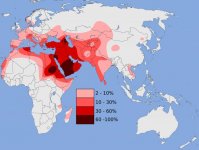We compared Mota to contemporary human populations (6). Both Principal Component Analysis (Fig. 1A) and outgroup f3 analysis using Ju|’hoansi (Khoisan) from Southern Africa as the outgroup (Fig. 1B,C) place this ancient individual close to contemporary Ethiopian populations, and more specifically to the Ari, a group of Omotic speakers from southern Ethiopia, to the West of the highland region where Mota lived. Our ancient genome confirms the view that the divergence of this language family results from the relative isolation of its speakers (8), and indicates population continuity over the last ~4,500 years in this region of Eastern Africa.
The age of Mota means that he should predate the West Eurasian backflow, which has been dated to ~3,000 years ago (3, 4). We formally tested this by using an f4 ratio estimating the West Eurasian component (6), following the approach adopted by Pickrell et al. (3). As expected, we failed to find any West Eurasian component in Mota (Table S5), thus providing support for previous dating of that event (3, 4).
Given that Mota predates the backflow, we searched for its most likely source by modelling the Ari, the contemporary population closest to our ancient genome, as a mixture of Mota and another West Eurasian population (6). We investigated both contemporary sources (3) as well as other Eurasian ancient genomes (5, 9). In this analysis, contemporary Sardinians and the early Neolithic LBK (Stuttgart) genome stand out (Fig. 2A). Previous analyses have shown Sardinians to be the closest modern representatives of early Neolithic farmers (10, 11), implying that the backflow came from the same genetic source that fuelled the Neolithic expansion into Europe from the Near East/Anatolia, before recent historic events changed the genetic makeup of populations living in that region. An analysis with haplotype sharing also identified a connection between contemporary Ethiopians and Anatolia (4, 12). Interestingly, archaeological evidence dates the arrival of Near Eastern domesticates (such as wheat, barley and lentils) to the same time period (circa 3,000 years ago) (13, 14), suggesting that the direct descendants of the farmers that earlier brought agriculture into Europe may have also played a role in the development of new forms of food production in the Horn of Africa.
Using Mota as an unadmixed African reference and the early farmer LBK as the source of the West Eurasian component, it is possible to reassess the magnitude and geographic extent of historical migrations, avoiding the complications of using admixed contemporary populations (6). We estimated a substantially higher Eurasian backflow admixture than previously detected (3), with an additional 4-7% of the genome of most African populations tracing back to a Eurasian source, and, more importantly, we detected a much broader geographical impact of the backflow, going all the way to West and Southern Africa (Fig. 2B). Even though the West Eurasian component in these regions is smaller than in Eastern Africa, it is still sizeable, with Yoruba and Mbuti, who are often used as African references (15, 16), showing 7% and 6%, respectively, of their genomes to be of Eurasian origin (Table S5).




